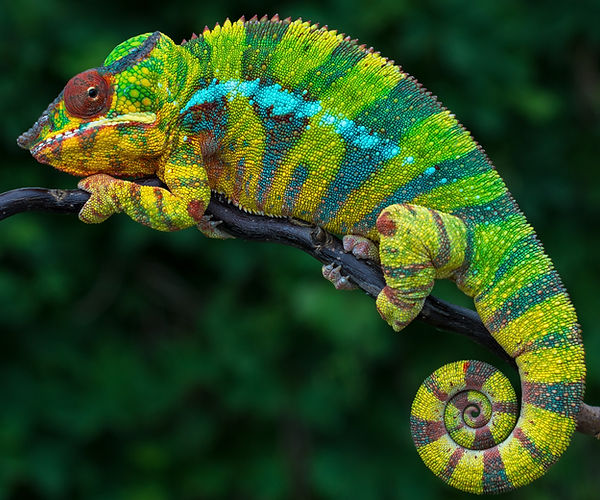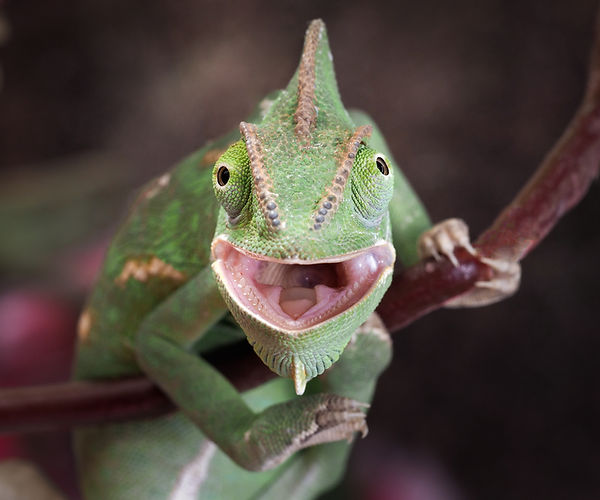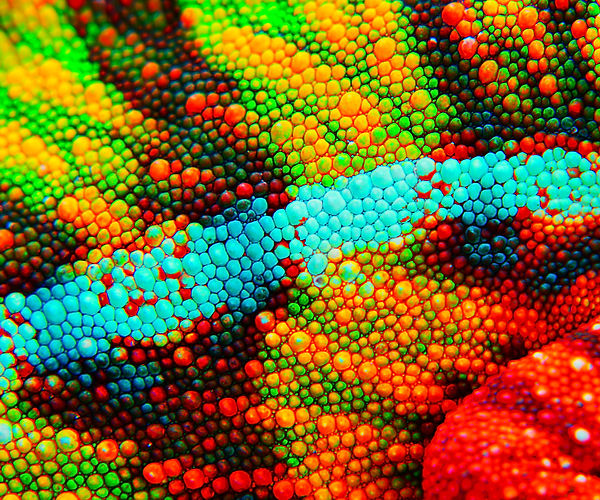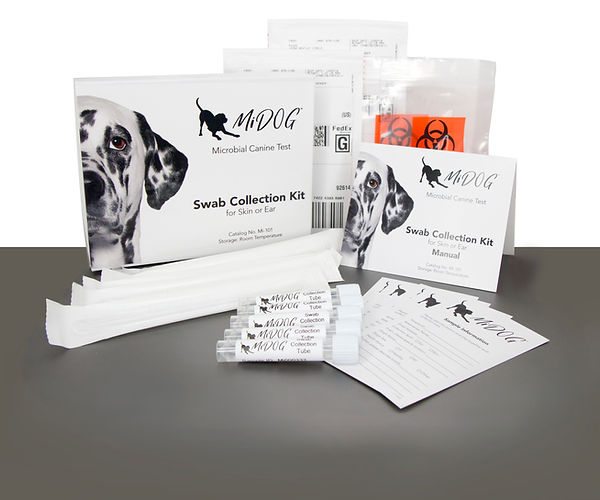
MiDOG technology can help diagnose your chameleon’s bacterial infections.
Chameleons are masters of disguise, especially when it comes to their well-being. Evolutionarily, chameleons have become adept at hiding possible sicknesses from predators, making it difficult for pet owners to identify warning signs of various maladies. Consequently, understanding possible sources of infections and how they manifest is critical for chameleon owners. It is important to note that while this article is going to focus on bacterial infections, there are several other diseases (ranging from dehydration to chameleon metabolic bone disease) that are common and necessitate immediate interventions. Visiting a veterinarian if you suspect your chameleon is sick is always recommended.
And so without further ado, here are three common bacterial infections to be on the lookout for your scaly best friend.
1. Stomatitis (Mouth Rot)
As one of the most common diseases in chameleons, stomatitis affects the oral cavity, tongue, palate, and/or esophagus. When an infection spreads untreated, inflammation of the mouth consisting of gingivitis, glossitis, palatitis, and cheilitis occurs [1]. While the initial exposure to opportunistic bacteria may be caused by physical trauma within the mouth, environmental factors such as misguided caretaking and nutritional care create the framework for infectious agents to thrive [2]. Specifically, gram-negative bacilli have been implicated in stomatitis manifestation. Moreover, Aeromonas is among the bacteria implicated as the classical causative agent of infectious stomatitis, along with several other bacteria such as Pseudomonas, Salmonella, Klebsiella, and Mycobacterium [3].
Symptoms include:
- Swelling in gums
- Yellow pus (aka cottage cheese mouth)
- Black plaque on teeth
- Changes in feeding behavior

The image above depicts the mouth of a healthy chameleon.
2. Respiratory Infections
Opportunistic bacteria can also invade a chameleon’s respiratory system, impacting your pet’s ability to breathe properly. Environmental factors play a large role in the development of respiratory infections, particularly when temperatures are kept too low or if the enclosure is too wet and humid [2]. Advances using Next-Gen Sequencing (NGS) technology have allowed researchers to identify M. granulomatis as a major cause of fungal glossitis and systemic mycosis in veiled chameleons [4]. M. viride was also an important fungal pathogen causing disseminated mycosis in chameleons [4].
Symptoms are wide-ranging and include:
- General breathing problems (wheezing, strain in breathing, etc.)
- Excessive mucus discharge from nose and mouth
- Changes in eating behavior
3. Skin Disorders
While skin disorder presentation in chameleons may appear as white bumps or dry sections on their skin, chameleons may also experience excessive shedding or even an inability to shed. The white bumps associated with chameleon skin disorders are caused by fungal and bacterial infections, with Chrysosporium species and Nannizziopsis draconii as examples of some of the fungi implicated in chameleon skin disorders [5]. Additionally, a recent study identified Chrysosporium anamorph of Nannizzioposis vriesii (CANV) in addition to several other Chrysosporium species to be the leading cause of fungal dermatitis in reptiles [6].
Symptoms include:
- White bumps and/or patches of dry and flaky skin
- Excessive/poor/difficulty shedding or not shedding at all

If you believe your chameleon’s behavior or appearance is deviating from the norm, you should take your reptile to an exotic pet veterinarian.
Prevention
As the Manual of Exotic Pet Practice puts it, “the majority of diseases observed in captive reptiles are directly associated with improper husbandry” [2]. Consequently, setting the proper temperature and humidity levels is key for your chameleon to maintain a healthy status, as an inability to do so allows for bacteria and fungi to thrive. A proper diet is also very important in maintaining optimal health for your chameleon, as vitamin deficiencies can leave your chameleon vulnerable to opportunistic pathogens.
Treatment and Diagnostics
Veterinarians recommend that chameleons visit every 6-12 months to ensure the well-being of these difficult-to-diagnose reptiles. The aforementioned infections in this article all may require medical intervention, with treatment ranging from topical antibacterial solutions to antibiotic courses. Your veterinarian will also help you identify possible lifestyle changes you and your chameleon can make to improve their quality of life and lessen the risk of recurrent infections. This entails understanding the exact pathogen that is impacting your chameleon, with modern technological advances allowing for more targeted clinical diagnostic interventions.
For example, a recent study assessing serpentovirus (nidovirus) and orthoreovirus coinfection in captive veiled chameleons with the respiratory disease found that “traditional diagnostic assays did not yield evidence of possible contributing infectious causes” [7]. However, metagenomics sequencing allowed the researchers to discover two novel serpentovirus sequences in veiled chameleons [7]. This indicates the clinical applicability of using genomic sequencing to identify, analyze, and eventually treat chameleons more effectively.
Despite its name, the MiDOG All-in-One microbiome test may provide the answer to the diagnostic conundrum that chameleon infections pose. Utilizing Next-Gen Sequencing technology to detect and quantify all microbial DNA through untargeted and comprehensive sequencing and quantitative comparisons to reference databases, the MiDOG NGS technology provides a useful opportunity to shed light on the microbial makeup of your chameleon’s infection for clinical application [8]. The MiDOG microbiome test is a microbial identification test grounded on scientific research that provides veterinarians DNA evidence for the guided treatment of chameleon infections, such as stomatitis, respiratory infections, and skin disorders,

The MiDOG Swab Collection Kit can diagnose your chameleon’s bacterial and fungal infections.
Find out if your vet uses MiDOG before you book your next appointment!
References:
[1] Schmidt V, Klasen L, Schneider J, Hübel J, Pees M. Fungal dermatitis, glossitis and disseminated visceral mycosis caused by different Metarhizium granulomatis genotypes in veiled chameleons (Chamaeleo calyptratus) and first isolation in healthy lizards. Vet Microbiol. 2017 Aug;207:74-82. doi: 10.1016/j.vetmic.2017.06.005. Epub 2017 Jun 10. PMID: 28757044.
[2] Deczm, M. M. D. M. P. & Tully Jr. DVM MS DABVP (Avian) DECZM (Avian), Thomas N. (2008). Manual of Exotic Pet Practice (1st ed.). Saunders.
[3] Singh, J., et. al. (2018). Infectious stomatitis in an Indian rock python (Python molurus) and its therapeutic management. 392-394.
[4] Schmidt, V., Klasen, L., Schneider, J., Hübel, J., & Pees, M. (2017). Characterization of Metarhizium viride Mycosis in Veiled Chameleons (Chamaeleo calyptratus), Panther Chameleons (Furcifer pardalis), and Inland Bearded Dragons (Pogona vitticeps). Journal of clinical microbiology, 55(3), 832–843. https://doi.org/10.1128/JCM.02206-16
[5] Sigler, L., Gibas, C. F. C., Kokotovic, B., & Bertelsen, M. F. (2010). Disseminated Mycosis in Veiled Chameleons (Chamaeleo calyptratus) Caused by Chamaeleomyces granulomatis, a New Fungus Related to Paecilomyces viridis. Journal of Clinical Microbiology, 48(9), 3182–3192. https://doi.org/10.1128/jcm.01079-10
[6] Pfeifer, M. (2019, January 9). Isolation of Nannizziopsis sp. from skin lesions of a veiled chameleon (Chamaeleo calyptratus ). Texas A&M Veterinary Medical Diagnostic Laboratory. https://tvmdl.tamu.edu/2019/01/15/isolation-of-nannizziopsis-sp-from-skin-lesions-of-a-veiled-chameleon-chamaeleo-calyptratus/
[7] Hoon-Hanks, L. L., Stöhr, A. C., Anderson, A. J., Evans, D. E., Nevarez, J. G., Díaz, R. E., Rodgers, C. P., Cross, S. T., Steiner, H. R., Parker, R. R., & Stenglein, M. D. (2020). Serpentovirus (Nidovirus) and Orthoreovirus Coinfection in Captive Veiled Chameleons (Chamaeleo calyptratus) with Respiratory Disease. Viruses, 12(11), 1329. https://doi.org/10.3390/v12111329
[8] Melgarejo, T., et al., 2021. Canine Urine Microbiome: Assessment of Bacterial and Fungal Populations in Clinically Healthy Dogs Using Next-Generation-Sequencing. Journal of Veterinary Internal Medicine. IN PRESS
